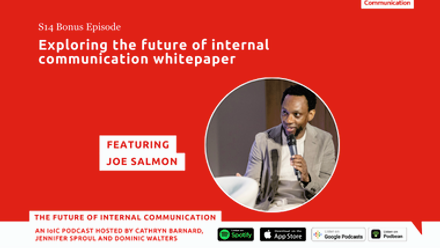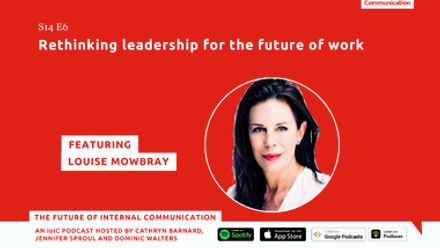Should I stay or should I go? A deeper dive into labour market complexity

But what does it tell us?
Drawing from the same data captured for the IC Index earlier in 2023, Should I Stay or Should I Go? explores employee sentiment toward job-seeking. As cost-of-living realities continue to loom large, interestingly, the report reveals that for the most part, employees aren’t in a hurry to move on.
But when they are, compensation and benefits – as well as the ability to perform in the role – are primary considerations.
As a work trend analyst, for me the ability to perform well in the role is a key insight, not least when considered alongside other research.
I was particularly drawn by the findings of the Building Mentally Healthy Workplaces report, published by MQ Mental Health Research, in partnership with Peopleful and NWU Workwell Research Unit in September 2023. This research, based on data collected from over 5,000 workers in the UK and Ireland, yielded rich intelligence.
The real cause of productivity lag
Mental ill-health is currently the leading cause of work absence. The World Health Organization estimates 12 billion working days are lost annually to depression. This costs some US$1 trillion a year to the global economy.
MQ Mental Health Research has identified 46% of surveyed employees were at risk of mental health difficulties in 2022.
Worse, burnout is on the rise. The report authors describe burnout as occurring when: “Employees feel overwhelmed and unable to meet constant work-related demands over an extended period and results in a loss of interest and motivation, and decreased productivity.” Their research showed 18% of their sample to be “in crisis” and a further 28% to be “struggling”.
That stress is so prevalent is hardly surprising given the turmoil of the past four years. The pandemic, the invasion of Ukraine, supply chain shortages, the cost-of-living crisis, endless political drama, the escalating climate crisis and now war in the Middle East – it’s not hard to see why we feel anxious and unsettled.
Against this backdrop, it’s also clear why so many organisations are doggedly determined to resume the routines and rhythm of pre-COVID life. But labour market turmoil continues to confound most C-suite executives. In a few short years we’ve witnessed a global pivot to working from home, followed by ‘The Great Resignation’, ‘languishing’, ‘quiet quitting’ and more.
Ongoing frictions between staff unwilling to relinquish the flexibility remote work has afforded and business leaders demanding a wholesale return to the office further strains employee relations. ‘Talent risk’ – the ability to access the right people and skills to deliver value at the right time – is now regarded as a key threat to business resilience.
Tools, equipment and systems failings
Building Mentally Healthy Workplaces reveals the primary drivers of workplace stress and burnout. It lists workload as the most significant driver and defines this as both systems and equipment that don’t work effectively and inadequate supervisory support.
We can all relate – being expected to deliver work outcomes using tools and equipment that don’t work properly is hugely challenging. Feeling unsupported by line managers is alienating and distressing.
The same report cites perceived person-job fit as the second cause of work-related stress. This occurs when someone has been recruited into a role or asked to take on new responsibilities, only to find they don’t enjoy or relate to the tasks being demanded of them. Again, many of us can recall a time when we didn’t enjoy our work as it wasn’t allowing us to fulfil our potential. Having no visible pathway to opportunities for professional learning and growth is frustrating. Yet the data showed only one in four felt they had access to career development.
This aligns with Ipsos Karian and Box’s research showing lack of career progression as a key reason why people pursue opportunities elsewhere.
A further workplace stress is emotional load – the extent to which employees have to deal with difficult people and/or situations at work. The report says:
“Research here has shown that unhealthy interaction styles at work, experiences of dysfunctional behaviour, including bullying behaviour, favouritism, and diversity difficulties, as well as inadequate support from colleagues and/or supervisors are the main contributors to emotional load in the workplace.”
It’s clear much work-related stress is communication related.
Let’s go a step further and integrate the findings of the recent Why UK PLC Needs Better Managers report published by the Chartered Management Institute. Its research reveals while one in four people in the workforce have management responsibility, a staggering 82% become managers without formal training.
With so little access to training, it’s easy to see why so many managers communicate in a way that’s unempathic, unrelatable or overly focused on bottom-line outcomes. And why so many people at work today feel disenfranchised, voiceless and invisible.
From here, the reasons why people leave jobs become ever clearer.
The opportunity for internal communication
Across the board, how we communicate with one another at work needs an upgrade.
Here’s where internal communication comes in.
We are wordsmiths, empaths and storytellers. We know how to build connection and community because we spend our days doing so.
But our colleagues are struggling to communicate meaningfully in a way that builds relationship, motivation and goodwill.
If ever there was an opportunity to add value, this is it. Once we understand what’s really going on at work, we become much better equipped to respond optimally.
Attitudes to work have changed and across the board, people are far less willing to tolerate poor working conditions and bad management. Where they elect to stay put, it’s clear their health is suffering.
It doesn’t have to be this way. If we can work with those colleagues who have people management responsibility, we can teach them good practice and educate on what empathic communication looks, sounds and feels like. We can help deliver enriching employee experiences.
When we can do that, internal communication will add more strategic value than any of us could ever have imagined.








